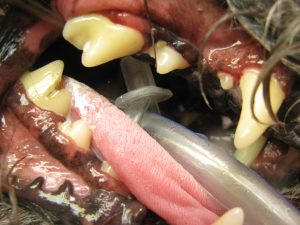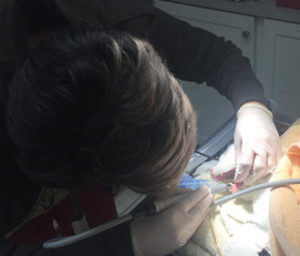 Your pet’s dental health plays a vital role in his general health and wellbeing. Veterinarians at Lincoln Avenue Veterinary Clinic can help you understand the factors involved in pet dental health and provide the targeted dental care your furry family member needs. Our clinic is pleased to offer comprehensive pet dental care including cleaning, anesthetized oral examination, digital dental x-rays and extractions when necessary.
Your pet’s dental health plays a vital role in his general health and wellbeing. Veterinarians at Lincoln Avenue Veterinary Clinic can help you understand the factors involved in pet dental health and provide the targeted dental care your furry family member needs. Our clinic is pleased to offer comprehensive pet dental care including cleaning, anesthetized oral examination, digital dental x-rays and extractions when necessary.
Signs of Dental Disease
Unlike humans, pets cannot simply tell you when they are feeling dental pain or discomfort. Common signs of dental disease in cats and dogs include:
- Persistent bad breath can indicate infection, periodontal disease, or another illness.
- Brown material (calculus) on tooth surfaces and red gums mean periodontal disease is present. A dental cleaning under anesthesia is necessary. Early and regular dental cleanings can reverse gingivitis. In advanced disease, tooth extractions are necessary to keep pets healthy and comfortable long-term.
- Behaviors such as drooling, dropping food, pawing at the muzzle, or chronic sneezing can indicate discomfort.
- Visible changes in your pet’s mouth or head, such as broken or missing teeth, bleeding from the mouth, a change in the symmetry of his muzzle, or abnormal discharge from the nose require immediate veterinary attention.
- As dental disease progresses, it makes eating and drinking uncomfortable for your pet. However, most pets will eat normally in spite of painful dental disease! Any changes in your pet’s appetite that do not pass within one to two days should be evaluated by a veterinarian.
Pet Dental Facts
- Studies have shown that over 80% of dogs and cats older than three years of age have periodontal disease (gingivitis and tooth attachment loss). This is a top health concern in our pets, and it can lead to painful infections!
- Dogs and cats have two sets of canine teeth– deciduous (baby) and permanent (adult). Many owners never notice when puppies or kittens lose their initial set and receive permanent teeth. However, in some animals, deciduous teeth do not fall out properly. This causes crowding, damages adult teeth, and increases the risk of oral infection if not addressed promptly by a veterinarian.
- Broken teeth not only affect your pet’s appearance but cause significant pain and infection risk. A broken tooth should always be treated by a veterinarian as soon as you notice it.
Dental Home Care
Brushing your cat or dog’s teeth is the best and cheapest way to maintain oral health and prevent gingivitis and tooth infections. Finger brushes or small, soft toothbrushes are acceptable. You may use either plain water or a special cat or dog toothpaste. Many pets enjoy having their teeth brushed because the toothpaste a tasty treat. Daily brushing is best; weekly brushing may be no better than not brushing at all. You brush your own teeth every day, so why not get your pet on board with regular dental home care? There are many good YouTube videos that demonstrate tips for tooth brushing.
If tooth brushing at home is not possible, we also offer a variety of dental chews and diets to help prevent periodontal disease. Although there are many products on the market, only a few are approved by the Veterinary Oral Health Council to effectively address periodontal disease. Of those preferred products, we carry Oravet and CET chews as well as Hills t/d dry food.
Periodontal Treatments in the Clinic
Even with the most diligent home care, most dogs and cats still need to have their teeth cleaned under anesthesia at some points in their lives. When you schedule a dental procedure at Lincoln Avenue Vet Clinic, services include:
- Pre-anesthetic blood work and ECG to make sure we use the safest anesthesia for your individual pet — These are recommended precautions that do carry an extra fee
- IV catheter, fluid therapy, pain medication, and careful patient monitoring throughout the procedure
- Ultrasonic scaling (the best way to clean under the gumline!) and tooth polishing
- Full-mouth digital dental x-rays to look for problems under the gumline
- A thorough oral exam by a veterinarian to check all sides of each tooth
- Local nerve blocks, tooth extractions and pain medication to go home if needed
San Jose Dental Exams and Cleaning


Lincoln Avenue Veterinary Clinic offers full mouth dental X-rays at no additional charge ($125 value), when your pet’s teeth are cleaned. We would need to have a current exam by one of our veterinarians before scheduling the dental cleaning to make sure your pet is an appropriate, safe candidate for this anesthetic procedure. This exam, the anesthesia, cleaning of the teeth, and any pre- or post cleaning procedures/tests would be charged at regular fees.
We now have digital dental x-rays (along w/ digital general x-rays of the body) which produce much cleaner, sharper, more diagnostic images than film. We can view the images within seconds of taking the x-ray, versus minutes while waiting for film to develop. This means a safer, shorter anesthetic experience for your pet versus film, and better diagnostics, which means better dental care for your pet.
Much of dental disease occurs below the gum line. This has been long recognized in people, where dental x-rays have long been used. Veterinary dentistry continues to evolve, and get better and better. Digital dental radiographs are another step toward providing better care for your pet.
Dental radiographs give us the ability to see if there are any abscesses at the root tips, root abnormalities, such as a hooked root tip (which would make extracting that root extremely difficult), fused roots, extra roots, bone loss along the roots (can be a very important part of periodontal disease that can only be fully recognized via x-rays), remaining root tips, fractures of the jaw bone, and “dead” teeth, to mention a few.
Please call our office for additional information and to schedule your pet’s exam! (408) 293-3448
Dental disease is one of the most common, if not the most common disease, found in our pets. This comes as a surprise to most people. It is an insidious disease, working constantly and silently, and in small increments, to steal away your pet’s health and long life. It can accelerate damage to the lungs, liver, heart, and kidneys. It can cause bad breath, excessive drooling, decreased appetite, dull and sharp oral pain, and make a pet grumpy. Just as we should go to our dentist on a regular basis for the best care, so should your pets.
Dental disease generally starts out as low-grade gingivitis, with redness and some swelling of the gum margins. There may or may not be VISIBLE calculi or tartar, the mineral deposits that form when plaque sits on the teeth long enough. Surprisingly, it only takes 3-5 days for plaque to start forming calculi. It only takes hours for plaque to form from the bad bacteria in the mouth. Thus, gingivitis is the result of an actual BACTERIAL INFECTION in the mouth under the gum line. It is because of this infection that all the damage to the gums, teeth, and bodily organs occurs, and why it should be treated. You can also see the need to have ONGOING CARE by us and by you. Home care is very important in fighting this ongoing battle.
Home care starts when the pets are young. This is the best time to introduce them to brushing of the teeth. Start with your finger. You want to gently insert your finger into their mouth between the cheek and teeth and move it back and forth. You can use just water or flavor your finger with food, broth, or something else tasty. Cats seem to like tuna juice. In kittens, a Q-tip can work better than your finger. The main thing is to make it an enjoyable experience for them and you or it won’t get done. Later you can work up to a washcloth or gauze squares, and then advance to toothbrushes.
 There are some pastes, gels, treats, chews, and even special foods which may, in some cases, be the ONLY thing your pet may tolerate instead of brushing. But brushing is still the best.
There are some pastes, gels, treats, chews, and even special foods which may, in some cases, be the ONLY thing your pet may tolerate instead of brushing. But brushing is still the best.
Do not give your pet hard objects to chew on because they can actually break the teeth! Hooves, Nylabones, “knuckle bones,” bones in general, hard plastic toys, Ice cubes and rocks fall under this category of hard objects.
Veterinary dental care involves identifying potential problems, anesthetizing the animal safely, evaluating the mouth, and then doing the procedures to deal with the problems found during the evaluation. The problem may just be early gingivitis. It may also be severe periodontal disease, where the tooth may be loose due to bone loss around the tooth, along with severe gingivitis.
For thorough evaluation, anesthesia is necessary. Anesthesia is very safe these days because of improved anesthetic techniques, better support and monitoring during anesthesia, and pre-anesthetic blood testing. All pets undergoing a dental procedure at LAVC require an IV catheter, at no extra cost, for direct IV access and fluid to support circulation and blood pressure during anesthesia.
Once anesthetized, the pet’s teeth and gums are checked for abnormally deep pockets alongside the roots, receding of the gum line, swelling of the gums, looseness of any teeth, or signs of tooth disease such as cavities, fractures, and exposed pulp. The teeth are then cleaned of any plaque and tartar using the latest techniques and equipment possible. Teeth that cannot be repaired will be extracted to prevent your pet from experiencing any unnecessary pain. In many cases, antibiotics will be dispensed to treat and or prevent infection.
We hope this helps you understand dental disease a little better. Our hope is that you can make an informed choice about the health care of your pet. Please feel free to ask any questions; contact us at (408) 293-3448.

